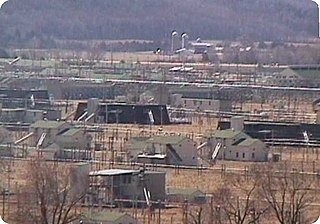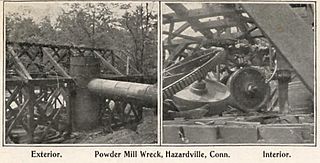
Gunpowder, also commonly known as black powder to distinguish it from modern smokeless powder, is the earliest known chemical explosive. It consists of a mixture of sulfur, carbon and potassium nitrate (saltpeter). The sulfur and carbon act as fuels while the saltpeter is an oxidizer. Gunpowder has been widely used as a propellant in firearms, artillery, rocketry, and pyrotechnics, including use as a blasting agent for explosives in quarrying, mining, building pipelines and road building.

Cordite is a family of smokeless propellants developed and produced in Britain since 1889 to replace black powder as a military firearm propellant. Like modern gunpowder, cordite is classified as a low explosive because of its slow burning rates and consequently low brisance. These produce a subsonic deflagration wave rather than the supersonic detonation wave produced by brisants, or high explosives. The hot gases produced by burning gunpowder or cordite generate sufficient pressure to propel a bullet or shell to its target, but not so quickly as to routinely destroy the barrel of the gun.

Éleuthère Irénée du Pont de Nemours was a French-American chemist and industrialist who founded the gunpowder manufacturer E. I. du Pont de Nemours and Company. His descendants, the du Pont family, have been one of America's richest and most prominent families since the 19th century, with generations of influential businessmen, politicians and philanthropists. In 1807, du Pont was elected a member of the American Philosophical Society in his adopted hometown of Philadelphia.

Smokeless powder is a type of propellant used in firearms and artillery that produces less smoke and less fouling when fired compared to gunpowder. The combustion products are mainly gaseous, compared to around 55% solid products for black powder. In addition, smokeless powder does not leave the thick, heavy fouling of hygroscopic material associated with black powder that causes rusting of the barrel.

Haskell is an unincorporated community located within Wanaque Borough, in Passaic County, New Jersey, United States. Haskell was formed in 1898 as a company town for a smokeless powder mill of the Laflin & Rand Powder Company. The town was named for Laflin & Rand company president Jonathan Haskell. The Haskell powder mill manufactured the W.A. .30 caliber smokeless powder used in United States Army service rifles until 1908. Laflin & Rand was purchased by DuPont in 1902, suffered from an explosion caused by sabotage in World War I, and the powder mill ceased operations in 1926. The area is served by the United States Postal Service as part of ZIP Code 07420. The community is located in suburban Northern New Jersey.

Francis Gurney du Pont was an American businessman and chemist who served as a vice president of E. I. du Pont de Nemours Company and invented smokeless gunpowder with the assistance of cousin Pierre S. du Pont. A member of the du Pont family, Francis had ten children, including E. Paul du Pont, founder of Du Pont Motors.
Hercules, Inc. was a chemical and munitions manufacturing company based in Wilmington, Delaware, United States, incorporated in 1912 as the Hercules Powder Company following the breakup of the DuPont explosives monopoly by the U.S. Circuit Court in 1911. Hercules Powder Company became Hercules, Inc. in 1966, operating under this name until 2008, when it was merged into Ashland Inc.

The Badger Army Ammunition Plant or Badger Ordnance Works (B.O.W.) is an excess, non-BRAC, United States Army facility located near Sauk City, Wisconsin. It manufactured nitrocellulose-based propellants during World War II, the Korean War, and the Vietnam War. It was a large munitions factory during World War II. As of 2013, the facility was in the end stages of demolition and remediation in preparation for property transfer.
Barwick, Great Barwick, and Little Barwick are hamlets in the civil parish of Standon in Hertfordshire, England. They are near the A10 road and the village of Much Hadham and the hamlet of Latchford. The River Rib flows behind Barwick and through Great Barwick. There is a ford crossing at Great Barwick.

From 1802 to 1921, Eleutherian Mills was a gunpowder mill site used for the manufacture of explosives founded by Eleuthère Irénée du Pont, which grew into the DuPont company. The name also refers to the house on the hill above the mills, which was the first du Pont family home in America. In 1957 the site became an outdoor museum when the Hagley Museum and Library was founded. The site was declared a National Historic Landmark in 1966.

A powder mill was a mill where gunpowder is made from sulfur, saltpeter and charcoal.

The Hodgdon Powder Company began in 1952 as B.E. Hodgdon, Inc., and has become a major distributor of smokeless powder for the ammunition industry, as well as for individuals who load their own ammunition by hand. The company's corporate office and manufacturing facilities are located in Kansas, United States. Hodgdon acquired IMR Powder Company in 2003. Winchester branded reloading powders have been distributed in the United States by Hodgdon since March 2006.

Improved military rifle propellants are tubular nitrocellulose propellants evolved from World War I through World War II for loading military and commercial ammunition and sold to civilians for reloading rifle ammunition for hunting and target shooting. These propellants were DuPont modifications of United States artillery propellants. DuPont miniaturized the large artillery grains to form military rifle propellants suitable for use in small arms. These were improved during the first world war to be more efficient in rimless military cartridges replacing earlier rimmed rifle cartridges. Four-digit numbers identified experimental propellants, and a few successful varieties warranted extensive production by several manufacturers. Some were used almost exclusively for military contracts, or commercial ammunition production, but a few have been distributed for civilian use in handloading. Improved military rifle propellants are coated with dinitrotoluene (DNT) to slow initial burning and graphite to minimize static electricity during blending and loading. They contain 0.6% diphenylamine as a stabilizer and 1% potassium sulfate to reduce muzzle flash.

The Hazard Powder Company is a former American manufacturer of gunpowder and explosives. It was located in Hazardville within the town of Enfield, Connecticut.

California Powder Works was the first American explosive powder manufacturing company west of the Rocky Mountains. When the outbreak of the Civil War cut off supplies of gunpowder to California's mining and road-building industries, a local manufacturer was needed. Originally located near Santa Cruz, California, the company was incorporated in 1861 and began manufacturing gunpowder in May 1864. For 50 years, it was a major employer in the county, employing between 150 and 275 men. The powder works was located on a flat adjacent to the San Lorenzo River, three miles upstream of Santa Cruz.
Oriental Powder Company was a gunpowder manufacturer with mills located on the Presumpscot River in Gorham and Windham, Maine. The company was one of the four largest suppliers to Union forces through the American Civil War.

The .45-75 WinchesterCentennial is a centerfire rifle cartridge developed in 1876 for the newly designed Winchester Model 1876 Centennial lever-action rifle. Winchester Repeating Arms Company introduced the rifle and cartridge at the United States Centennial Exposition. The Model 1876 rifle used an enlarged version of the famous Winchester Model 1873 action to offer a lever-action repeating rifle using cartridges suitable for big-game hunting. The cartridge and rifle enjoyed brief popularity with Gilded Age American hunters including Theodore Roosevelt, and was issued to the Canadian North-West Mounted Police and to Texas Rangers.
American Powder Mills (1883–1929) was a Massachusetts gunpowder manufacturing complex on the Assabet River. It expanded to include forty buildings along both sides of the river in the towns of Acton, Concord, Maynard, and Sudbury. Press mills, kernelling mills, glazing mills, and storehouses were dispersed over four-hundred acres to minimize damage during explosions. A narrow gauge railway transferred raw materials and products between the buildings.
Miami Powder Company operated a gunpowder manufacturing complex on the Little Miami River at Goes Station, Ohio from 1855 to 1925. Willows growing along the banks of the Little Miami River provided the charcoal required for gunpowder. Production was approximately 75 percent rifle powder and 25 percent blasting powder.

IMR Legendary Powders is a line of smokeless powders which are popularly used in sporting and military/police firearm cartridges. The initials 'IMR' stand for Improved Military Rifle powder. IMR powders makes a line of various types of smokeless powder suitable for loading many cartridges for rifles, handguns, and shotguns.
















